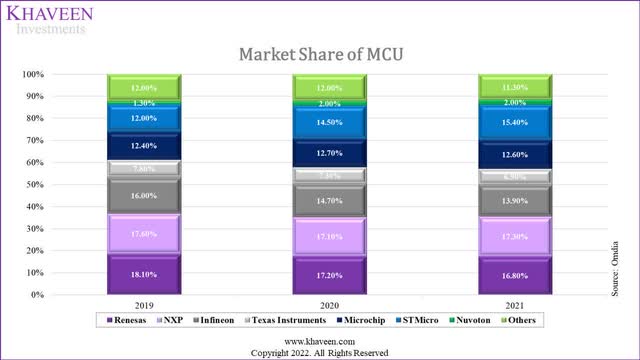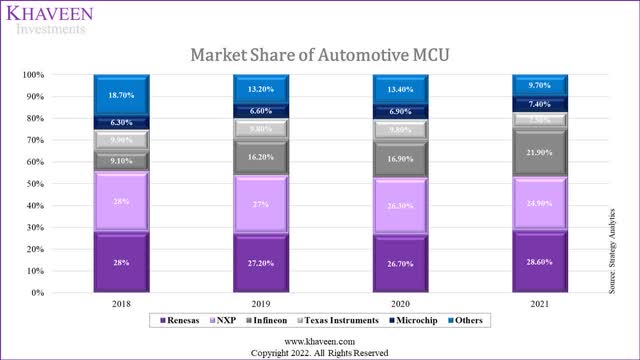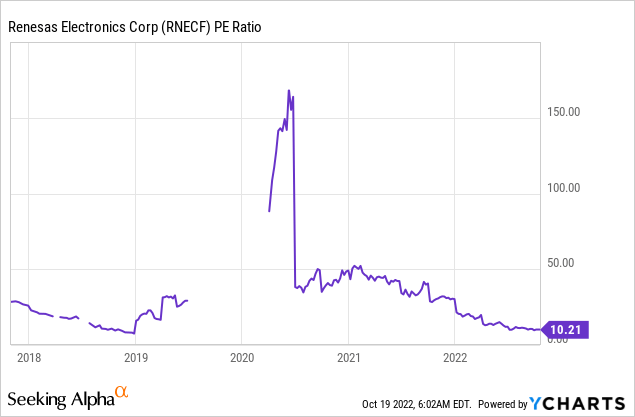
Sundry Photography
Sundry Photography
In this analysis of Renesas Electronics Corporation (OTCPK:RNECF), we analyzed the company’s MCU business segment which represented 38% of revenue and is its second-largest product segment behind Analog at 41% of revenue. As seen in the chart below, the company had lost market share in the past 3 years of the MCU market and lost its market leadership position to NXP (NXPI) in 2021 as it had higher average revenue growth of 12.1% compared to 8.8% for Renesas.
As the company lost market share in the MCU market, we analyzed its revenue growth in the past 3 years based on its MCU revenue as well as the company’s reported revenue segment breakdown. Furthermore, we compared the company’s MCU product portfolio to determine if it has a performance and product breadth advantage over competitors. Lastly, we analyzed the company’s MCU revenue based on its automotive MCU revenue and non-automotive MCU revenue.

Omdia, Khaveen Investments
Omdia, Khaveen Investments
MCU Revenue Growth %
2020
2021
Average
Renesas
-6.1%
23.6%
8.8%
NXP
-4.0%
28.1%
12.1%
Infineon (OTCQX:IFNNY)
-9.2%
19.7%
5.3%
Texas Instruments (TXN)
-7.5%
19.7%
6.1%
Microchip (MCHP)
1.2%
25.6%
13.4%
Average
12.1%
Source: Omdia, Khaveen Investments
Based on the table above, the company’s MCU revenue grew at an average of 8.8% in the past 2 years based on Omdia data. This is below the average growth of the top 5 competitors including NXP, Infineon, Texas Instruments and Microchip. Among these competitors, Microchip had the highest growth rate followed by NXP. Therefore, despite Renesas losing market share, the company’s MCU revenue still had positive growth but at a lower average than its competitors.
Additionally, we analyzed the revenue breakdown of the company’s segment in the past 5 years in the table below.
Segment Revenue (JPY mln)
2017
2018
2019
2020
2021
Average
Automotive
413,082
389,683
371,145
341,001
462,309
Growth %
-5.66%
-4.76%
-8.12%
35.57%
4.26%
Industrial/Infrastructure/IoT
353,428
346,569
329,705
363,609
515,547
Growth %
-1.94%
-4.87%
10.28%
41.79%
11.32%
Other
12,745
20,521
17,393
11,063
16,562
Growth %
61.01%
-15.24%
-36.39%
49.71%
14.77%
Total Revenue
779,255
756,773
718,243
715,673
994,418
Growth %
-2.9%
-5.1%
-0.4%
38.9%
7.65%
Source: Renesas, Khaveen Investments
As seen above, the company’s two main segments are Automotive and Industrial/Infrastructure/IoT. The company had average total revenue growth of 7.65%. The company’s Industrial/Infrastructure/IoT segment had higher revenue growth than its automotive segment at an average of 11.32% compared to 4.26%.
Thus, despite the company losing market share, we believe it still had positive revenue growth but underperformed compared to competitors, which could indicate the company’s disadvantage in MCUs against competitors with below-average growth.
To identify the possible factor for its low growth compared to competitors, we compared the company’s MCU products in the table below based on maximum frequency performance, bit size, and RAM to determine whether Renesas has superior performance compared to competitors. Additionally, we compared the companies in terms of the breadth of their portfolios by the number of MCU products listed on Digikey.
Overall MCUs
Max Frequency Performance (MHz)
Bit Size
Max RAM (‘mb’)
Number of Products
Texas Instruments (Arm-based MCUs)
800
24
5.12
21,455
Renesas (RX Portfolio)
240
32
1.024
15,637
NXP (ARM Cortex-M MCUs Powerhouse Portfolio)
528
32
0.256
31,216
Infineon (AURIX 32-bit)
300
32
6.912
33,206
Microchip (PIC32MZ EF)
300
32
0.64
57,924
Average
434
30
3
31,888
Source: Company Data, Digikey, Khaveen Investments
Based on the table, Renesas RZ portfolio has the lowest maximum frequency performance compared to competitors with similar bit sizes to NXP, Infineon and Microchip but with lower max RAM capacities than the average. Thus, we believe this indicates the performance disadvantage of Renesas over competitors. Furthermore, in terms of product portfolio breadth, Renesas has the lowest number of total products from Digikey which highlights its weakness compared to competitors. In comparison, Microchip has the highest number of products and the highest revenue growth in the overall MCU market as discussed in the first point.
Therefore, we believe that Renesas has a weaker portfolio breadth compared to its competitors of the top 5 MCU suppliers with the lowest number of products on top of its performance disadvantage with lower than average frequency and max RAM capacities.
Moreover, we analyzed the company’s MCU business for its automotive segment. In the table below, we compiled the market share data from Strategy Analytics of the automotive MCU market share.

Strategy Analytics, Khaveen Investments
Strategy Analytics, Khaveen Investments
Company
Average 2-year Automotive MCU Revenue Growth
Average 2-year Non-Automotive MCU Revenue Growth
Renesas
12.50%
4.20%
NXP
4.50%
21.50%
Infineon
29.20%
-11.10%
Texas Instruments
-5.40%
16.80%
Microchip
15.60%
12.90%
Average
11.30%
8.90%
Source: Strategy Analytics, IC Insights, Khaveen Investments
Based on the table above, Renesas’ market share in automotive MCU declined from 28% in 2018 to 2020 but recovered in 2021 and maintained its market leadership with a 28.6% market share with average revenue growth of 12.5% in the past 2 years. The only companies with above-average revenue growth were Renesas, Microchip and Texas Instruments. On the other hand, NXP continued to lose market share from 2018 and joined Texas Instruments as the only other company within the top 5 to lose share. Meanwhile, Infineon close the gap on NXP and its share surged in 2019 following its acquisition of Cypress. Moreover, Microchip also gained market share but remained in the 5th position.
In comparison, we calculated the non-automotive MCU revenue growth among the top 5 competitors. Renesas has below-average growth compared to its competitors at 4.2% in the past 2 years while NXP has the highest growth as it overtook Renesas to become the market leader. Thus, despite its high Industrial/Infrastructure/IoT segment revenue growth, its non-automotive MCU revenue growth had been lower than its automotive MCU revenue growth. Based on the company’s presentation, its Analog revenue as a % of total revenue had increased from 30% in 2019 to 41% in 2021 whereas its MCU revenue declined from 47% to 38% in the period. Thus, we believe that the company’s higher Industrial/Infrastructure/IoT segment growth compared to its automotive could be due to the superior growth of its Analog product revenue.
Automotive MCUs
Max Frequency Performance (MHz)
Bit Size
Max RAM (‘mb’)
Number of Products
Texas Instruments (TMS570, TMS320F28x)
300
32
0.516
87
Renesas (RH 850)
400
32
5.12
23
NXP (MAC57D5xx MCUs)
320
32
1.3
35
Infineon (AURIX 32-bit TriCore)
300
32
6.912
198
Microchip (PIC32MZ EF, SAM V7x)
300
32
0.64
198
Average
324
32
3
108
Source: Company Data, Digikey, Khaveen Investments
Based on the table, we analyzed the company’s automotive MCU portfolio based on maximum frequency performance, bit size and RAM capacity as well as the number of products. Renesas RH 850 portfolio has the highest frequency performance and above-average maximum RAM capacities which indicates its performance advantage. Though, it has the lowest number of products which highlights its weaker product breadth. Infineon and Microchip, the two companies with the highest average revenue growth had the largest portfolio breadth (198 products). Although Renesas has the lowest number of products, it had above-average revenue growth which we believe could be due to its performance advantage over competitors with the highest frequency performance.
Based on the company’s latest earnings briefing, management indicated that the company’s utilization rate was over 90%. Additionally, the company’s utilization rate had increased since Q1 2020. We believe this highlights the tight supply situation of the company and could pose a threat to its revenue growth outlook.
All in all, despite the company losing market share of the overall MCU market to NXP in 2021, the company still had positive MCU revenue growth but lower than its competitors at an average of 8.8% compared to 12.1% for the top 5 companies and positive growth across both Automotive and Industrial/Infrastructure/IoT segments. Based on a comparison of the top 5 companies’ portfolios, we determined that Renesas has a disadvantage in terms of product performance and its portfolio breadth with the lowest number of products. Furthermore, we compared the company’s automotive and non-automotive MCU revenue growth where its automotive revenue growth had been higher than non-automotive despite its superior Industrial/Infrastructure/IoT segment growth which we believe is due to the higher growth of its Analog products.

Based on the analyst consensus price target, the company has an upside of 77.9% with a target price of JPY2,176.92, thus we rate the company as a Strong Buy as its stock price had declined by 24% YTD. Moreover, the company’s current PE ratio of 10.21x is lower than its 5-year average of 37.18x, thus we believe highlights its undervaluation.
This article was written by
Disclosure: I/we have no stock, option or similar derivative position in any of the companies mentioned, but may initiate a beneficial Long position through a purchase of the stock, or the purchase of call options or similar derivatives in RNECF over the next 72 hours. I wrote this article myself, and it expresses my own opinions. I am not receiving compensation for it (other than from Seeking Alpha). I have no business relationship with any company whose stock is mentioned in this article.
Additional disclosure: No information in this publication is intended as investment, tax, accounting, or legal advice, or as an offer/solicitation to sell or buy. Material provided in this publication is for educational purposes only, and was prepared from sources and data believed to be reliable, but we do not guarantee its accuracy or completeness.